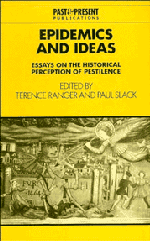Book contents
- Frontmatter
- Contents
- Contributors
- Preface
- 1 Introduction
- 2 Epidemic, ideas and classical Athenian society
- 3 Disease, dragons and saints: the management of epidemics in the Dark Ages
- 4 Epidemic disease in formal and popular thought in early Islamic Society
- 5 Plague and perceptions of the poor in early modern Italy
- 6 Dearth, dirt and fever epidemics: rewriting the history of British ‘public health’, 1780–1850
- 7 Epidemics and revolutions: cholera in nineteenth-century Europe
- 8 Hawaiian depopulation as a model for the Amerindian experience
- 9 Plague panic and epidemic politics in India, 1896–1914
- 10 Plagues of beasts and men; prophetic responses to epidemic in eastern and southern Africa
- 11 Syphilis in colonial East and Central Africa: the social construction of an epidemic
- 12 The early years of AIDS in the United Kingdom 1981–6: historical perspectives
- Index
- Past and Present Publications
12 - The early years of AIDS in the United Kingdom 1981–6: historical perspectives
Published online by Cambridge University Press: 05 August 2011
- Frontmatter
- Contents
- Contributors
- Preface
- 1 Introduction
- 2 Epidemic, ideas and classical Athenian society
- 3 Disease, dragons and saints: the management of epidemics in the Dark Ages
- 4 Epidemic disease in formal and popular thought in early Islamic Society
- 5 Plague and perceptions of the poor in early modern Italy
- 6 Dearth, dirt and fever epidemics: rewriting the history of British ‘public health’, 1780–1850
- 7 Epidemics and revolutions: cholera in nineteenth-century Europe
- 8 Hawaiian depopulation as a model for the Amerindian experience
- 9 Plague panic and epidemic politics in India, 1896–1914
- 10 Plagues of beasts and men; prophetic responses to epidemic in eastern and southern Africa
- 11 Syphilis in colonial East and Central Africa: the social construction of an epidemic
- 12 The early years of AIDS in the United Kingdom 1981–6: historical perspectives
- Index
- Past and Present Publications
Summary
INTRODUCTION
Anthony Sampson, author of that well-known cross between journalism and contemporary history, Anatomy of Britain, recently commented on the relationship between the two. His view was that historical perspectives and methodologies should be applied to very recent events. Otherwise, one could miss that ‘real vibrant sense of history as happening just around the corner’. This chapter, in that genre, focusses on the analysis of a very recent series of events – the advent of AIDS in the United Kingdom and the initial reactions in terms of policies and of conceptions of disease, between 1981 and 1986. It has two broad aims – first, to examine the ways in which the new disease was defined as an issue for health policy and as an issue for scientists and the public, and the ways in which expertise and experts also defined themselves in relation to AIDS. And secondly, it aims to draw from the particular instance of this analysis of AIDS policies, some more general reflections about history, in terms of content, methodologies and concepts, and the different forms of its relationship with public policy in the health area as illustrated through AIDS.
We have suggested the identification and categorisation of three distinct policy phases for AIDS in the UK. The first (1981–6) saw the slow growth of AIDS into a national policy issue. Policy was essentially, and in particular at the beginning, formed in a bottom up rather than top-down way.
- Type
- Chapter
- Information
- Epidemics and IdeasEssays on the Historical Perception of Pestilence, pp. 303 - 328Publisher: Cambridge University PressPrint publication year: 1992
- 5
- Cited by

